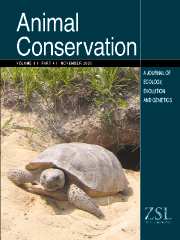Crossref Citations
This article has been cited by the following publications. This list is generated based on data provided by
Crossref.
Durban, J. W.
Elston, D. A.
Ellifrit, D. K.
Dickson, E.
Hammond, P. S.
and
Thompson, P. M.
2005.
MULTISITE MARK-RECAPTURE FOR CETACEANS: POPULATION ESTIMATES WITH BAYESIAN MODEL AVERAGING.
Marine Mammal Science,
Vol. 21,
Issue. 1,
p.
80.
Berger, Joel
Cain, Steven L
and
Berger, Kim Murray
2006.
Connecting the dots: an invariant migration corridor links the Holocene to the present.
Biology Letters,
Vol. 2,
Issue. 4,
p.
528.
LUSSEAU, DAVID
WILSON, BEN
HAMMOND, PHILIP S.
GRELLIER, KATE
DURBAN, JOHN W.
PARSONS, KIM M.
BARTON, TIM R.
and
THOMPSON, PAUL M.
2006.
Quantifying the influence of sociality on population structure in bottlenose dolphins.
Journal of Animal Ecology,
Vol. 75,
Issue. 1,
p.
14.
Learmonth, J
MacLeod, C
Santos, M
Pierce, G
Crick, H
and
Robinson, R
2006.
Oceanography and Marine Biology.
p.
431.
Schofield, Gail
Bishop, Charles M.
MacLean, Grant
Brown, Peter
Baker, Martyn
Katselidis, Kostas A.
Dimopoulos, Panayotis
Pantis, John D.
and
Hays, Graeme C.
2007.
Novel GPS tracking of sea turtles as a tool for conservation management.
Journal of Experimental Marine Biology and Ecology,
Vol. 347,
Issue. 1-2,
p.
58.
Gregr, Edward J.
and
Bodtker, Karin M.
2007.
Adaptive classification of marine ecosystems: Identifying biologically meaningful regions in the marine environment.
Deep Sea Research Part I: Oceanographic Research Papers,
Vol. 54,
Issue. 3,
p.
385.
Johnson, Amber
and
Acevedo-Gutiérrez, Alejandro
2007.
Regulation compliance by vessels and disturbance of harbour seals (Phoca vitulina).
Canadian Journal of Zoology,
Vol. 85,
Issue. 2,
p.
290.
Berghan, J.
Algie, K. D.
Stockin, K.A.
Wiseman, N.
Constantine, R.
Tezanos‐Pinto, G.
and
Mourão, F.
2008.
A preliminary photo‐identification study of bottlenose dolphin(Tursiops truncatus)in Hauraki Gulf, New Zealand.
New Zealand Journal of Marine and Freshwater Research,
Vol. 42,
Issue. 4,
p.
465.
Culloch, Ross M.
and
Robinson, Kevin P.
2008.
Bottlenose dolphins using coastal regions adjacent to a Special Area of Conservation in north-east Scotland.
Journal of the Marine Biological Association of the United Kingdom,
Vol. 88,
Issue. 6,
p.
1237.
Kovacs, Kit M.
and
Lydersen, Christian
2008.
Climate Change Impacts on Seals and Whales in the North Atlantic Arctic and Adjacent Shelf Seas.
Science Progress,
Vol. 91,
Issue. 2,
p.
117.
Gambaiani, D.D.
Mayol, P.
Isaac, S.J.
and
Simmonds, M.P.
2009.
Potential impacts of climate change and greenhouse gas emissions on Mediterranean marine ecosystems and cetaceans.
Journal of the Marine Biological Association of the United Kingdom,
Vol. 89,
Issue. 1,
p.
179.
Williams, Rob
Lusseau, David
and
Hammond, Philip S.
2009.
The role of social aggregations and protected areas in killer whale conservation: The mixed blessing of critical habitat.
Biological Conservation,
Vol. 142,
Issue. 4,
p.
709.
Bearzi, Maddalena
Saylan, Charles A.
and
Hwang, Alice
2009.
Ecology and comparison of coastal and offshore bottlenose dolphins (Tursiops truncatus) in California.
Marine and Freshwater Research,
Vol. 60,
Issue. 6,
p.
584.
Shucksmith, Richard
Jones, Nia H.
Stoyle, George W.
Davies, Andrew
and
Dicks, Emily F.
2009.
Abundance and distribution of the harbour porpoise (Phocoena phocoena) on the north coast of Anglesey, Wales, UK.
Journal of the Marine Biological Association of the United Kingdom,
Vol. 89,
Issue. 5,
p.
1051.
Barnett, J.
Davison, N.
Deaville, R.
Monies, R.
Loveridge, J.
Tregenza, N.
and
Jepson, P. D.
2009.
Postmortem evidence of interactions of bottlenose dolphins (Tursiops truncatus) with other dolphin species in south‐west England.
Veterinary Record,
Vol. 165,
Issue. 15,
p.
441.
Schofield, Gail
Hobson, Victoria J.
Fossette, Sabrina
Lilley, Martin K. S.
Katselidis, Kostas A.
and
Hays, Graeme C.
2010.
BIODIVERSITY RESEARCH: Fidelity to foraging sites, consistency of migration routes and habitat modulation of home range by sea turtles.
Diversity and Distributions,
Vol. 16,
Issue. 5,
p.
840.
Bearzi, Maddalena
and
Saylan, Charles A.
2011.
Cetacean Ecology for Santa Monica Bay and Nearby Areas, California, in the Context of the Newly Established MPAs.
Bulletin, Southern California Academy of Sciences,
Vol. 110,
Issue. 2,
p.
35.
Ross, Peter S.
Barlow, Jay
Jefferson, Thomas A.
Hickie, Brendan E.
Lee, Tatiana
MacFarquhar, Christina
Christien Parsons, E.
Riehl, Kimberly N.
Rose, Naomi A.
Slooten, Elisabeth
Tsai, Chia-Yang
Wang, John Y.
Wright, Andrew J.
and
Chu Yang, Shih
2011.
Ten guiding principles for the delineation of priority habitat for endangered small cetaceans.
Marine Policy,
Vol. 35,
Issue. 4,
p.
483.
Gnone, Guido
Bellingeri, Michela
Dhermain, Frank
Dupraz, Franck
Nuti, Silvio
Bedocchi, Davide
Moulins, Aurelie
Rosso, Massimiliano
Alessi, Jessica
McCrea, Rachel S.
Azzellino, Arianna
Airoldi, Sabina
Portunato, Nicola
Laran, Sophie
David, Lea
Di Meglio, Nathalie
Bonelli, Patrizia
Montesi, Gionata
Trucchi, Roberta
Fossa, Fulvio
and
Wurtz, Maurizio
2011.
Distribution, abundance, and movements of the bottlenose dolphin (Tursiops truncatus) in the Pelagos Sanctuary MPA (north-west Mediterranean Sea).
Aquatic Conservation: Marine and Freshwater Ecosystems,
Vol. 21,
Issue. 4,
p.
372.
Quick, Nicola J.
and
Janik, Vincent M.
2012.
Bottlenose dolphins exchange signature whistles when meeting at sea.
Proceedings of the Royal Society B: Biological Sciences,
Vol. 279,
Issue. 1738,
p.
2539.


